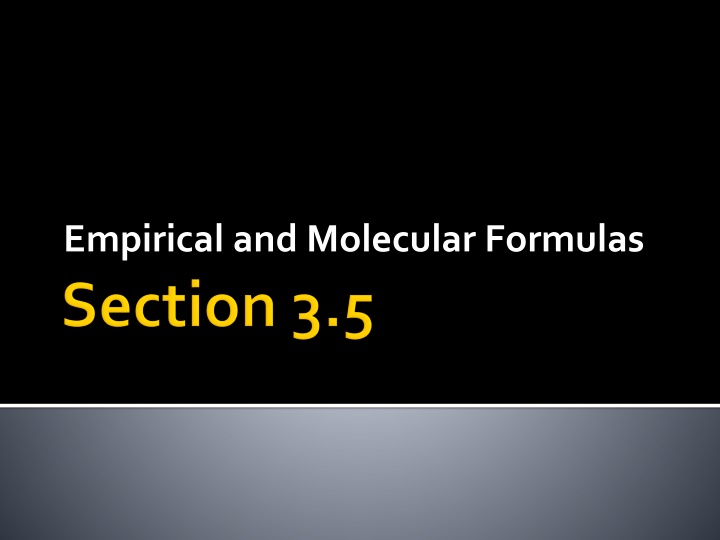
Empirical and Molecular Formulas in Chemistry
Learn about empirical and molecular formulas in chemistry, where empirical formulas show the lowest ratio of elements in a compound, and molecular formulas depict the actual number of each element. Follow a step-by-step process to determine empirical formulas and find real examples like the empirical formula of ascorbic acid as C3H4O3. Understand the relationship between empirical and molecular weights to derive molecular formulas accurately.
Download Presentation

Please find below an Image/Link to download the presentation.
The content on the website is provided AS IS for your information and personal use only. It may not be sold, licensed, or shared on other websites without obtaining consent from the author. If you encounter any issues during the download, it is possible that the publisher has removed the file from their server.
You are allowed to download the files provided on this website for personal or commercial use, subject to the condition that they are used lawfully. All files are the property of their respective owners.
The content on the website is provided AS IS for your information and personal use only. It may not be sold, licensed, or shared on other websites without obtaining consent from the author.
E N D
Presentation Transcript
Empirical Formulas tell us relative number of atoms of each element in compound (lowest ratio) Molecular Formulas show the actual number of each atom in a compound (may or may not be lowest ratio)
1. Assume 100 grams and change % signs to grams 2. Convert each element from grams to moles (keep at least three sig figs don t round too much!) 3. Select the element with the smallest amount of moles 4. Divide all of the mole numbers by the smallest one (the smallest will now equal 1) 5. Find the whole number ratio among the elements to use as their subscripts in the empirical formula
Compound is 73.9% Hg and 26.1% Cl. Find empirical formula. Assume 100 grams 73.9 g Hg x (1 mol Hg) = 0.368 mol Hg 0.368 = 1 200.59 g Hg 26.1 g Cl x (1 mol Cl) = 0.736 mol Cl 0.368= 2 35.45 g Cl = HgCl2
Find the empirical and molecular formulas for ascorbic acid which is 40.92% C, 4.58% H, and 54.50 %O. Its molecular weight is 264 amu.
Whole number multiple = molecular weight empirical formula weight
Empirical formula = C3H4O3 Find empirical formula weight: 3(12.01) + 4(1.01) + 3(16.00) = 88.07 amu Given: experimentally determined molecular weight = 264 amu W.N.M.= molecular weight empirical formula weight 88.07 = 264 = 2.997 = 3 Molecular Formula = C9H12O9






















